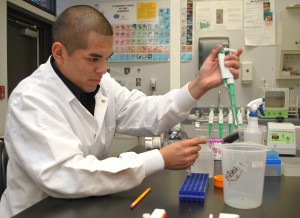
A student at Oklahoma's Ardmore High School works on an assignment for a biotechnical program, which is designed to introduce students to careers in fields like chemistry and microbiology.
This spring, parents in the San Diego Unified School District in California rose in protest when the district proposed to add CTE courses as a graduation requirement. Parents signed a petition and argued that CTE would water down the educational experience of their college-bound students. Education officials, surprised by the backlash, said the proposal was simply intended to prepare students for both college and career, according to a recent article in U.S. News on NBCnews.com.
“Career and technical education has come a long way since the days when students could be steered from academics into hairstyling, auto repairs or carpentry. But that doesn’t mean it’s easy to sell the concept of having all students take courses in CTE, as it is known,†wrote Sarah Butrymowicz of The Hechinger Report in the article.
CTE leaders have been taking on the issue of CTE’s stigma for more than a decade, said Kimberly Green, NASDCTEc Executive Director. A turning point came about 10 years ago when the CTE community transitioned program names from vocational education to CTE as a way to shed images of outdated shop classes.
“Career and technical education meant something different than vocational education,†Green said. “It’s academics plus technical instruction.â€
Just over a year ago, NASDCTEc launched a re-branding initiative called CTE: Learning that works for Americaâ„¢ to again change minds about CTE. The campaign continues and the work continues across states.
In California, CTE programs have been elevating their status. In recent years, a growing number of CTE courses have been approved towards the University of California and California State University systems’ “a-g†entry requirements – the list of courses that students may complete in high school to be eligible for admittance to the universities. Those courses include academic core classes and electives.
Gary Hoachlander, president of ConnectEd, a California group that works with districts to create career-oriented high school and college programs for students, said there are about 10,000 CTE courses across all the state’s districts qualify for the college requirement. However, most of those courses count as electives.
CTE science classes such as environmental science or agricultural s
ience have yet to be approved for academic credit. “That’s where I think there’s still a lot of work to do,†Hoachlander said.
Erin Uy, Communications & Marketing Manager
Tags: California, college and career readiness, Hechinger Report, news, Oklahoma

